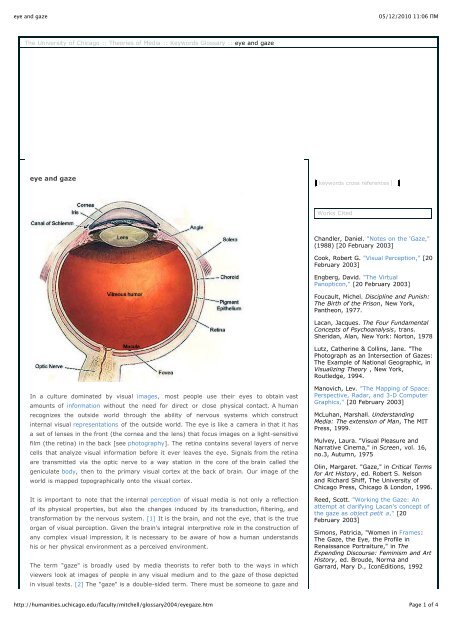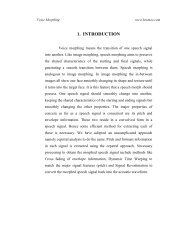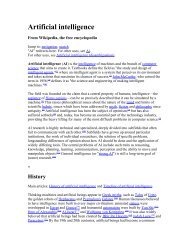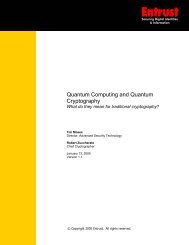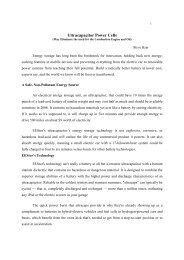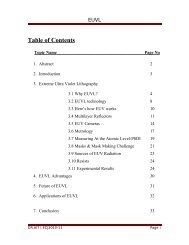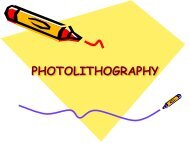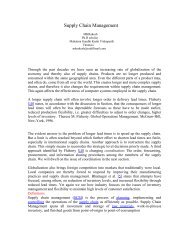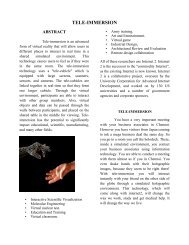Eye and Gaze.pdf - 123SeminarsOnly
Eye and Gaze.pdf - 123SeminarsOnly
Eye and Gaze.pdf - 123SeminarsOnly
You also want an ePaper? Increase the reach of your titles
YUMPU automatically turns print PDFs into web optimized ePapers that Google loves.
eye <strong>and</strong> gaze<br />
The University of Chicago :: Theories of Media :: Keywords Glossary :: eye <strong>and</strong> gaze<br />
eye <strong>and</strong> gaze<br />
In a culture dominated by visual images, most people use their eyes to obtain vast<br />
amounts of information without the need for direct or close physical contact. A human<br />
recognizes the outside world through the ability of nervous systems which construct<br />
internal visual representations of the outside world. The eye is like a camera in that it has<br />
a set of lenses in the front (the cornea <strong>and</strong> the lens) that focus images on a light-sensitive<br />
film (the retina) in the back [see photography]. The retina contains several layers of nerve<br />
cells that analyze visual information before it ever leaves the eye. Signals from the retina<br />
are transmitted via the optic nerve to a way station in the core of the brain called the<br />
geniculate body, then to the primary visual cortex at the back of brain. Our image of the<br />
world is mapped topographically onto the visual cortex.<br />
It is important to note that the internal perception of visual media is not only a reflection<br />
of its physical properties, but also the changes induced by its transduction, filtering, <strong>and</strong><br />
transformation by the nervous system. [1] It is the brain, <strong>and</strong> not the eye, that is the true<br />
organ of visual perception. Given the brain's integral interpretive role in the construction of<br />
any complex visual impression, it is necessary to be aware of how a human underst<strong>and</strong>s<br />
his or her physical environment as a perceived environment.<br />
The term "gaze" is broadly used by media theorists to refer both to the ways in which<br />
viewers look at images of people in any visual medium <strong>and</strong> to the gaze of those depicted<br />
in visual texts. [2] The "gaze" is a double-sided term. There must be someone to gaze <strong>and</strong><br />
http://humanities.uchicago.edu/faculty/mitchell/glossary2004/eyegaze.htm<br />
keywords cross references<br />
Works Cited<br />
05/12/2010 11:06 ΠΜ<br />
Ch<strong>and</strong>ler, Daniel. "Notes on the '<strong>Gaze</strong>,"<br />
(1988) [20 February 2003]<br />
Cook, Robert G. "Visual Perception," [20<br />
February 2003]<br />
Engberg, David. "The Virtual<br />
Panopticon," [20 February 2003]<br />
Foucault, Michel. Discipline <strong>and</strong> Punish:<br />
The Birth of the Prison, New York,<br />
Pantheon, 1977.<br />
Lacan, Jacques. The Four Fundamental<br />
Concepts of Psychoanalysis, trans.<br />
Sheridan, Alan, New York: Norton, 1978<br />
Lutz, Catherine & Collins, Jane. "The<br />
Photograph as an Intersection of <strong>Gaze</strong>s:<br />
The Example of National Geographic, in<br />
Visualizing Theory , New York,<br />
Routledge, 1994.<br />
Manovich, Lev. "The Mapping of Space:<br />
Perspective, Radar, <strong>and</strong> 3-D Computer<br />
Graphics," [20 February 2003]<br />
McLuhan, Marshall. Underst<strong>and</strong>ing<br />
Media: The extension of Man, The MIT<br />
Press, 1999.<br />
Mulvey, Laura. "Visual Pleasure <strong>and</strong><br />
Narrative Cinema," in Screen, vol. 16,<br />
no.3, Autumn, 1975<br />
Olin, Margaret. "<strong>Gaze</strong>," in Critical Terms<br />
for Art History, ed. Robert S. Nelson<br />
<strong>and</strong> Richard Shiff, The University of<br />
Chicago Press, Chicago & London, 1996.<br />
Reed, Scott. "Working the <strong>Gaze</strong>: An<br />
attempt at clarifying Lacan's concept of<br />
the gaze as object petit a," [20<br />
February 2003]<br />
Simons, Patricia, "Women in Frames:<br />
The <strong>Gaze</strong>, the <strong>Eye</strong>, the Profile in<br />
Renaissance Portraiture," in The<br />
Expending Discourse: Feminism <strong>and</strong> Art<br />
History, ed. Broude, Norma <strong>and</strong><br />
Garrard, Mary D., IconEditions, 1992<br />
Page 1 of 4
eye <strong>and</strong> gaze<br />
there may be someone to gaze back. To give the gaze is to perceive that one is looking at<br />
an object. To set oneself at gaze is to expose oneself to view or display oneself. [3]<br />
Words for the agent of gazing are beholder, viewer, <strong>and</strong> occasionally spectator or<br />
audience. Like a person, gaze also can be exchanged in a medium. Several key forms of<br />
gaze can be identified in photographic, filmic or televisual tests, or in figurative graphic art<br />
based on who is doing the looking: the spectator's gaze, the intra-diegetic gaze, the direct<br />
or extra-diegetic address to the viewer, <strong>and</strong> the look of the camera. [4]<br />
The antiquity of the discourse on gaze can be seen in such myths as that of the evil eye<br />
<strong>and</strong> the gorgon Medusa, whose gaze could turn its object to stone. Folkloric<br />
representations of eyes sought to protect their wearers from the power of the evil gaze. In<br />
the nineteenth century, the discourse on the visually perceptual object was centered on an<br />
opposition between the optical <strong>and</strong> tactile senses. The tactile sense placed us in contact<br />
with reality while the optical sense was regarded as the sense of the intellect, the spirit,<br />
<strong>and</strong> the imagination. Impressionists <strong>and</strong> symbolists were attracted by the fact that optical<br />
perception seemed to unite the subjectivity of artistic vision with the objectivity of the<br />
external world. It survived in the work of critics of the mid-twentieth century who used<br />
formal criteria to interpret such artistic movements as abstract expressionism. This<br />
discourse was continued, but replaced to a large extent by the term "gaze." In early<br />
twentieth-century, German expressionism exploited the sense of power in images that<br />
stared out at the viewer menacingly. The charisma of the gaze came to its peak in Hitler,<br />
who prided himself on his hypnotic gaze. Jean-Paul Sartre's almost paranoid treatment of<br />
" le regard " (the look) in his treatise on existential philosophy, Being <strong>and</strong> Nothingness ,<br />
portrayed the state of being watched as a threat to the self. [5]<br />
A late-twentieth century interest in the eye <strong>and</strong> the gaze has been largely investigated so<br />
far in terms of psychoanalysis. According to Jacques Lacan, human recognition of the<br />
visual object is overlaid with mis-recognition. In "Of the <strong>Gaze</strong> as object petit a " Lacan<br />
indicates some sort of outside observer; the imagery petit a is the lure for the subject's<br />
desire. [6] The embodiment of object petit a is what we may call the gaze. According to<br />
Lacan, the subject's attempt to view the other must pass through the intermediary. The<br />
plane mirror provides a virtual image that covers up the fundamental lack in the real<br />
image. Thus, the gaze corresponds to desire, the desire for self-completion through the<br />
other. "The eye <strong>and</strong> the gaze--this is for us the split in which the drive is manifested at the<br />
level of the scopic field." [7] In this permutation the gaze is the unattainable object of<br />
desire that seemed to make the other complete. However, for Lacan, it is important to<br />
underst<strong>and</strong> that the eye <strong>and</strong> gaze, although split, are part of the same person. [8]<br />
Marshall McLuhan, in his Underst<strong>and</strong>ing Media: The extensions Man, refers to the tragedy<br />
of Narcissus caused by the misrecognition of his own image: "The Greek myth of Narcissus<br />
is directly concerned with a fact of human experience, as the word Narcissus indicates. It<br />
is from the Greek word narcosis, or numbness. The youth Narcissus mistook his own<br />
reflection in the water for another person. This extension of himself by mirror numbed his<br />
perceptions until he became the servomechanism of his own extended or repeated image.<br />
The nymph Echo tried to win his love with fragments of his own speech, but in vain. He<br />
was numb. He had adapted to his extension of himself <strong>and</strong> had become a closed system."<br />
[9]<br />
Lev Manovich notes that Lacan emphasizes that perspective extends beyond the domain of<br />
the visible. Manovich points out that Lacan reminds us that an image is anything defined<br />
"by the correspondences from one point to another in space" [10] <strong>and</strong> the idea that<br />
perspective is not only limited to sight but also functions in other senses defines the<br />
classical discourses on perception: "The whole trick, the key presto!, of the classic dialectic<br />
around perception, derives from the fact that it deals with geometric vision, that is to say,<br />
with vision in so far as it situated in a space that is not in its essence the visual." [11]<br />
Manovich argues that Lacan's clarification that the principle of perspective is not limited to<br />
the visible helps us underst<strong>and</strong> that the technologies of remote sensing function on the<br />
principle of perspective. According to Manovich, regardless of their lengths, all waves<br />
travel in straight lines, <strong>and</strong> therefore points in space are connected by straight lines to a<br />
http://humanities.uchicago.edu/faculty/mitchell/glossary2004/eyegaze.htm<br />
Notes<br />
05/12/2010 11:06 ΠΜ<br />
[1] Cook, Robert G., "Visual Perception,"<br />
<br />
[2] Ch<strong>and</strong>ler, "Note on the '<strong>Gaze</strong>',"<br />
<br />
[3]Oxford English Dictionary Online<br />
"<strong>Gaze</strong>,"<br />
.<br />
[4] Ch<strong>and</strong>ler, op. cit.<br />
[5] See Olin, Margaret, in Critical Terms<br />
for Art History , ed. Robert S. Nelson<br />
<strong>and</strong> Richard Shiff, The University of<br />
Chicago Press, Chicago & London, 1996,<br />
pp.208-214.<br />
[6] Reed, Scott, "Working the <strong>Gaze</strong>: An<br />
attempt at clarifying Lacan's concept of<br />
the gaze as object petit a ,"<br />
<br />
[7] Lacan, Jacques, "The <strong>Eye</strong> <strong>and</strong> the<br />
<strong>Gaze</strong>," in The Four Fundamental<br />
Concepts of Psychoanalysis , trans.<br />
Sheridan, Alan, New York: Norton,<br />
1978, p. 73.<br />
[8] Olin, Margaret, op. cit., p. 215.<br />
[9] McLuhan, Marshall, Underst<strong>and</strong>ing<br />
Media: The extension of Man, The MIT<br />
Press, 1999, p. 41.<br />
[10] Lacan, Jacques, op.cit., p. 93.<br />
[11] Ibid., p. 94.<br />
[12] Manovich, Lev, "The Mapping of<br />
Space: Perspective, Radar, <strong>and</strong> 3-D<br />
Computer Graphics,"<br />
<br />
[13] Lacan, op. cit., p. 94.<br />
[14] Ch<strong>and</strong>ler, op. cit.<br />
[15] Mulvey, Laura, "Visual Pleasure <strong>and</strong><br />
Narrative Cinema," in Screen, vol.16,<br />
no.3, Autumn, 1975, p. 9.<br />
[16] Ibid., p. 11.<br />
[17] See Simons, Patricia, "Women in<br />
Frames: The <strong>Gaze</strong>, the <strong>Eye</strong>, the Profile<br />
in Renaissance Portraiture," in The<br />
Expending Discourse: Feminism <strong>and</strong> Art<br />
History , ed. Broude, Norma <strong>and</strong><br />
Garrard, Mary D., pp. 39-57.<br />
[18] Foucault, Discipline <strong>and</strong><br />
punishment: The Birth of the Prison ,<br />
New York, Pantheon, p. 155.<br />
[19] Engberg, David, "The Virtual<br />
Panopticon,"<br />
<br />
[20] Foucault, op. cit., p. 25.<br />
[21] Lutz, Catherine & Collins, Jane,<br />
"The Photograph as an Intersection of<br />
<strong>Gaze</strong>s: The Example of National<br />
Geographic, in Visualizing Theory , New<br />
Page 2 of 4
eye <strong>and</strong> gaze<br />
point of reception (such as radar antenna) or recording (such as photographic camera).<br />
[12] Radar, infrared imaging, sonar, or ultrasound are all part of what Lacan called<br />
"geometric vision," perspectival vision which extends beyond the visible. [13]<br />
On the other h<strong>and</strong>, the film theorist Christian Merz made an analogy between the cinema<br />
screen <strong>and</strong> mirror, arguing that by identifying with the gaze of the camera, the cinema<br />
spectator re-enacts Lacan's "the mirror stage," [14] the moment when a child recognizes<br />
its own image in the mirror as an idealized image of itself. In "Visual Pleasure <strong>and</strong><br />
Narrative Cinema," Laura Mulvey also made use of psychoanalytic theories of Lacan <strong>and</strong><br />
Sigmund Freud to explore the practices of representation <strong>and</strong> spectatorship in films.<br />
Mulvey argues that cinematic viewing is the interplay between narcissistic identification <strong>and</strong><br />
erotic voyeurism. In his Three Essays on Sexuality, Sigmund Freud associated scopophilia<br />
with the pleasure involved in looking at other people's bodies as objects. Mulvey argues<br />
that cinema satisfies a primordial wish for pleasurable looking, but it also goes further,<br />
developing scopophilia in its narcissistic aspect. [15] According to Mulvey, "pleasure in<br />
looking has been split between active/male <strong>and</strong> passive/female. The determining male<br />
gaze projects its fantasy onto the female figure which is styled accordingly. In their<br />
traditional exhibitionist role women are simultaneously looked at <strong>and</strong> displayed, with their<br />
appearance coded for strong visual <strong>and</strong> erotic impact so that they can be said to connote<br />
to-be-looked-at-ness ." [16]<br />
Many feminist art historians also have presented historical instances of the dominating<br />
"male gaze" <strong>and</strong> the socio-cultural uses of the female body as signifier. For instance,<br />
Patricia Simons explores the female profile portrait in fifteenth-century Florence. She<br />
argues that the operations of the gaze in a "display culture" in which the presentation of<br />
the female sitter with "an averted eye <strong>and</strong> a face available to scrutiny" served the needs of<br />
a strongly male-dominated society in which brides <strong>and</strong> wives were visible emblems of<br />
status <strong>and</strong> property exchange. For this reason, the portraits were not so much images of<br />
human individuals as they were highly idealized "bearers of wealth," presenting a fixed<br />
display of fetishized body parts, dress, <strong>and</strong> ornament to the appraising male eye. [17]<br />
Michel Foucault related the "inspecting gaze" to power rather than to gender in his<br />
discussion of surveillance. For Foucault, the asymmetry of seeing-without-being-seen in<br />
the panopticon is the very essence of power. Jeremy Bentham envisioned the panopticon<br />
or "all-seeing place" to provide complete observation of every prisoner. The panopticon<br />
serves as a laboratory of humans, with data collected <strong>and</strong> collated through what Foucault<br />
termed "the gaze": an inspecting gaze which each individual under its weight will end by<br />
interiorizing to the point that he is his own overseer, each individual thus exercising this<br />
surveillance over, <strong>and</strong> against, himself. A superb formula: power exercised continuously<br />
<strong>and</strong> for what turns out to be minimal cost. [18] The faceless prisoners of this space are<br />
held in darkness, illuminated only by roving spotlights that prevent them from observing<br />
their observers, reinforcing Foucault's idea of a citizen who "is seen, but he does not see;<br />
he is the object of information, never a subject in communication." [19]<br />
The functions of photography can be seen in the context of Foucault's analysis of the rise<br />
of surveillance in modern society. Photography promotes "the normalizing gaze, a<br />
surveillance that makes it possible to qualify, to classify <strong>and</strong> to punish. It establishes over<br />
individuals a visibility through which one differentiates <strong>and</strong> judges them." [20] On the<br />
other h<strong>and</strong>, Catherine Lutz <strong>and</strong> Jane Collins combine Foucault's "inspecting gaze" <strong>and</strong><br />
Lacan's "mirror stage" to still photography. They argue that "mirror <strong>and</strong> camera are tools<br />
of self reflection <strong>and</strong> surveillance. Each creates a double of the self, a second figure who<br />
can be examined more closely than the original - a double that can also be alienated from<br />
the self - taken away, as a photograph can be, to another place." [21]<br />
The idea of "all-seeing" comes in the form of literal observation through cameras in public<br />
spaces <strong>and</strong> electronic monitoring of workers. The view is that a society is being<br />
constructed where all behavior will be sharply regulated through the fear of theoretical<br />
observation by some oppressive entity. [22] "There has been much ballyhoo about the<br />
liberating <strong>and</strong> decentralizing aspects of new media technologies like the Internet <strong>and</strong><br />
http://humanities.uchicago.edu/faculty/mitchell/glossary2004/eyegaze.htm<br />
05/12/2010 11:06 ΠΜ<br />
Geographic, in Visualizing Theory , New<br />
York, Routledge, 1994, p. 376.<br />
[22] See Engberg, op. cit.<br />
[23] Ibid.<br />
Page 3 of 4
eye <strong>and</strong> gaze<br />
ubiquitous computing, but the fact remains that new information technologies will be<br />
every bit as effective for established organizations as they will be for garage e-zine<br />
publishers. It still remains to be seen to what extent the new media technologies will in<br />
fact increase the centralization of power by facilitating unprecedented monitoring <strong>and</strong><br />
observation." [23]<br />
Phil Lee<br />
Department of Art History<br />
Winter 2003<br />
The University of Chicago :: Theories of Media :: Keywords Glossary :: eye <strong>and</strong> gaze<br />
http://humanities.uchicago.edu/faculty/mitchell/glossary2004/eyegaze.htm<br />
05/12/2010 11:06 ΠΜ<br />
Page 4 of 4


